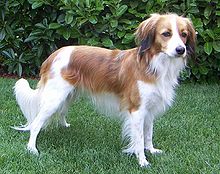The Kooikerhondje[a] is a small spaniel-type dog breed of Dutch ancestry that was originally used as a working dog, particularly in a decoy to lure ducks. The breed dates back to the 16th century and makes frequent appearances in paintings from the Dutch Golden Age.
| Kooikerhondje | |||||||||||||||||
|---|---|---|---|---|---|---|---|---|---|---|---|---|---|---|---|---|---|
 A two-year-old Kooikerhondje | |||||||||||||||||
| Other names |
| ||||||||||||||||
| Origin | Netherlands | ||||||||||||||||
| |||||||||||||||||
| Dog (domestic dog) | |||||||||||||||||
Description
editAppearance
editThe Kooikerhondje is a small, spaniel-like sporting dog. Originally bred in the Netherlands as a duck hunting dog, it has a white plumed tail for the purpose of attracting ducks.[1]
The preferred height at the withers is 40 centimetres (16 in) for males and 38 centimetres (15 in) for females.[2] The FCI standard allows a range of 38 to 41 centimetres (15 to 16 in) for males, and 36 to 39 centimetres (14 to 15 in) for females.[3] The breed has a wavy, medium-length double coat,[4] and its coloration is white and orange-red.[2] Some Kooikerhondjes have black ear tips, which are referred to as "earrings".[1]
Health
editA number of heritable diseases have been identified in the Kooikerhondje, including inflammatory myopathy,[5] Type III von Willebrand's disease,[6] necrotising myelopathy,[7] renal dysplasia,[8] patellar luxation,[9] and ataxia.[10] A Dutch study of 842 Kooikerhondjes found that patellar luxation was prevalent in 24% of dogs scanned. During the time period of the study — which started in 1994 and ended in 2011 — the prevalence of the condition fell from 28% to 19%, although the prevalence is still higher than for other spaniel dogs.[9]
History
editThe Kooikerhondje was developed in the Netherlands sometime around the 16th century in order to lure ducks into duck decoys where hunters could easily catch the fowl. The hunting style of the Kooikerhondje was inspired by foxes, as Dutch hunters realized that ducks were enticed by foxes playing near water, as long as they didn't make eye contact.[1]
The Kooikerhondje frequently appears in paintings by Dutch masters such as Jan Steen, Rembrandt, and Johannes Vermeer.[1] The breed is believed to be an ancestor of the Nova Scotia Duck Tolling Retriever.[1]
The breed almost became extinct during World War II until Baroness van Hardenbroek van Ammerstol rescued it. The breed was not officially recognized by the Dutch Kennel Club until 1971[11] and has since been imported into other countries and recognized officially. In January 2013, the Kennel Club announced it was reclassifying the Kooikerhondje from the gun dog group to the utility group effective from January 2014. The decision was reached after discussions with the U.K. breed clubs and unanimous agreement was achieved.[12]
The Kooikerhondje was recognized by the American Kennel Club in 2018.[13] The breed gained fame in the United States in the 2020s, in part due to Decoy Ohtani, a Kooikerhondje owned by baseball player Shohei Ohtani.[14]
See also
editNotes
edit- ^ Dutch pronunciation: [koːi̯kərhɔɲcə]; roughly translating to "decoy dog" in Dutch[1]
References
edit- ^ a b c d e f "Facts About the Nederlandse Kooikerhondje That You May Not Know". American Kennel Club. February 9, 2024. Retrieved 2024-11-30.
- ^ a b "Nederlandse Kooikerhondje" (PDF). American Kennel Club. Retrieved 24 July 2018.
- ^ "Nederlandse Kooikerhondje" (PDF). Fédération Cynologique Internationale. Retrieved 7 February 2024.
- ^ "Nederlandse Kooikerhondje - Dog Breed Information". American Kennel Club. Retrieved 2024-11-30.
- ^ Opmeer, Yvet; Grinwis, Guy C. M.; Shelton, G. Diane; Rosati, Marco; Alf, Vanessa; Fieten, Hille; Leegwater, Peter A. J.; Matiasek, Kaspar; Mandigers, Paul J. J. (2023-04-29). "An Inflammatory Myopathy in the Dutch Kooiker Dog". Animals. 13 (9). MDPI AG: 1508. doi:10.3390/ani13091508. ISSN 2076-2615. PMC 10177195. PMID 37174546.
- ^ Slappendel, R.J.; Beijer, E.G.M.; van Leeuwen, M. (1998). "Type III von Willebrand's disease in Dutch kooiker dogs". Veterinary Quarterly. 20 (3). Informa UK Limited: 93–97. doi:10.1080/01652176.1998.9694847. ISSN 0165-2176. PMID 9684296.
- ^ Mandigers, P.J.J.; van Nes, J.J.; Knol, B.W.; Ubbink, G.J.; Gruys, E. (1993). "Hereditary necrotising myelopathy in Kooiker dogs". Research in Veterinary Science. 54 (1). Elsevier BV: 118–123. doi:10.1016/0034-5288(93)90020-g. ISSN 0034-5288. PMID 8434139.
- ^ Schulze, C.; Meyer, H.P.; Blok, A.L.; Schipper, K.; van den Ingh, T.S.G.A.M. (1998). "Renal dysplasia in three young adult dutch kooiker dogs". Veterinary Quarterly. 20 (4). Informa UK Limited: 146–148. doi:10.1080/01652176.1998.9694861. ISSN 0165-2176. PMID 9810631.
- ^ a b Wangdee, C.; Leegwater, P.A.J.; Heuven, H.C.M.; van Steenbeek, F.G.; Meutstege, F.J.; Meij, B.P.; Hazewinkel, H.A.W. (2014). "Prevalence and genetics of patellar luxation in Kooiker dogs". The Veterinary Journal. 201 (3). Elsevier BV: 333–337. doi:10.1016/j.tvjl.2014.05.036. ISSN 1090-0233. PMID 24986317.
- ^ PJ, Mandigers; JJ, van Nes; BW, Knol; GJ, Ubbink; E, Gruys (1993). "Hereditary Kooiker dog ataxia". Tijdschrift voor Diergeneeskunde. 118 (Suppl 1). Tijdschr Diergeneeskd: 65S. ISSN 0040-7453. PMID 8480326. Retrieved 2024-02-06.
- ^ "Vereniging Het Nederlandse Kooikerhondje". Vereniging Het Nederlandse Kooikerhondje (in Dutch). 2024-11-29. Retrieved 2024-11-30.
- ^ "Kooikerhondje moves to utility". Dog World. Archived from the original on 1 November 2013. Retrieved 17 January 2013.
- ^ "Dog meet dog: American Kennel Club adds 2 breeds to roster". AP News. 2018-01-10. Retrieved 2024-11-30.
- ^ "Meet Decoy Ohtani, perhaps the most valuable pet of the World Series". AP News. 2024-11-01. Retrieved 2024-11-30.
External links
edit- Media related to Kooikerhondje at Wikimedia Commons